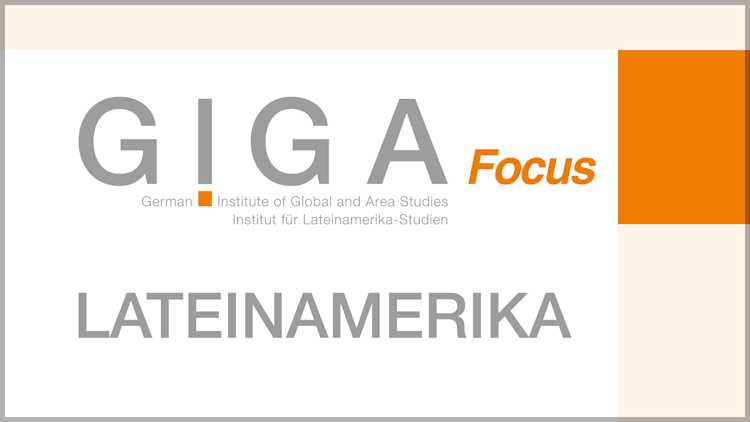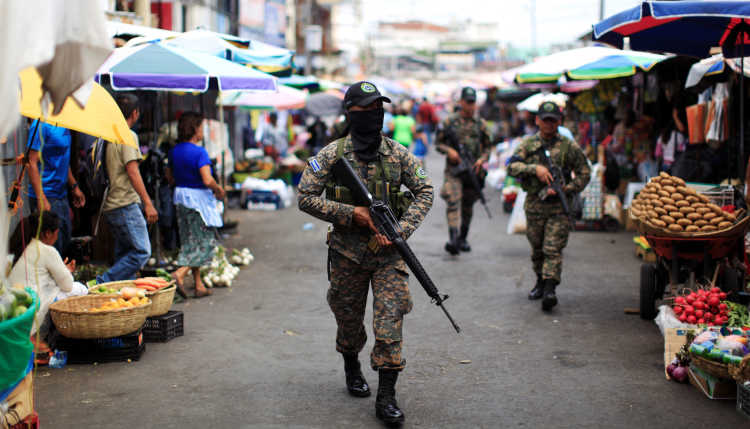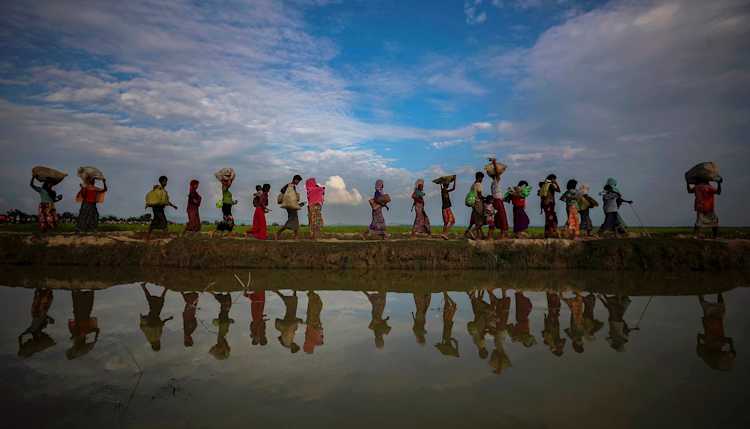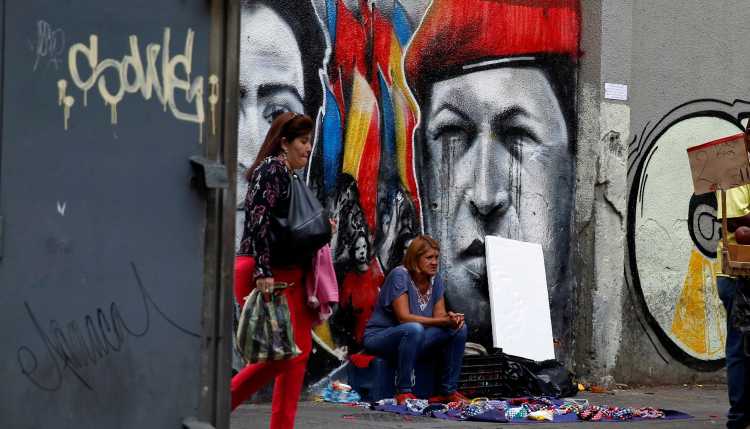- Startseite
- Publikationen
- GIGA Focus
- Venezuelan Migration Crisis Puts the Region's Democratic Governability at Risk
GIGA Focus Lateinamerika
Venezuelas Migrationskrise bedroht die demokratische Regierbarkeit der Region
Nummer 6 | 2018 | ISSN: 1862-3573

Während Venezuela zunehmend autoritärer regiert wird, nimmt die Verarmung der Bevölkerung weiter zu. Eine der größten Migrationswellen in der Geschichte Lateinamerikas ist die Folge. Seit dem Jahr 2014 sind 2,3 Millionen Venezolaner aus dem Land geflohen.
Die Politisierung von Venezuelas staatseigener Ölfirma, Petróleos de Venezuela (PDVSA), hat seit dem Jahr 2013 zu einem Einbruch der Produktion auf fast die Hälfte geführt. In der Folge können der „Petrostaat“ und seine Gesellschaft nicht mehr durch Öleinnahmen aufrechterhalten werden, sodass wirtschaftliche Engpässe Millionen Menschen zur Emigration zwingen.
Venezuelas massive Abwanderung schlägt sich in der ganzen Region nieder, allen voran in Kolumbien, Ecuador, Peru und Brasilien. Die humanitäre Krise wird zunehmend zu einer Bedrohung der demokratischen Regierbarkeit in Südamerika und dies zu einem Zeitpunkt, an dem die Fähigkeit zu regionaler Problembewältigung ein neues Tief erreicht hat.
Die venezolanische Krise hat zu einer politischen Teilung Lateinamerikas geführt. Die Union Südamerikanischer Nationen (UNASUR) ist praktisch zerfallen, da Kolumbien und Paraguay aus ihr ausgetreten sind und Argentinien, Brasilien, Chile und Peru ihre Mitgliedschaft ausgesetzt haben.
Fazit
Südamerika zeigt sich unfähig, eigenständig eine Lösung für die Krise in Venezuela zu finden. Weder UNASUR noch die Gemeinschaft der Lateinamerikanischen und Karibischen Staaten (CELAC) waren zu einem kohärenten Krisenmanagement in der Lage. Daher ist es erforderlich, die Organisation Amerikanischer Staaten (OAS) wiederzubeleben und im Namen regionaler Governance zu ihren Prinzipen und Werten zurückzukehren. Dies ist nicht nur notwendig, um die aktuelle venezolanische Krise zu bewältigen, sondern auch um zu verhindern, dass diese zu einem Vorbild für autoritäre Strömungen in anderen Ländern der Region wird.
The Venezuelan Transition to Full Authoritarianism
On 2 February 2019, the so-called Bolivarian Revolution launched by Hugo Chávez will have been in power for 20 years. Initially the project enjoyed significant popular support, as it set out to expand the rights of the people and to deepen democracy. It ended by burying one of the oldest and most prosperous democracies in Latin America. The result has been one of the largest waves of emigration the region has ever seen.
Until mid-2017, the dominant thesis for explaining this phenomenon had been competitive authoritarianism (Levitsky and Way 2010). According to this theory, Chávez’s Venezuela was a hybrid regime with a high concentration of power in the presidency, arbitrary economic practices, and an authoritarian institutional performance – but it was legitimised by frequent elections. However, Chávez’s death made it clear that the model of electoral legitimacy was exhaustible, due to the impossibility of charismatic transfer and the collapse of an economic model based on indiscriminate public spending and corruption. This opened up space for the transition to a fully authoritarian regime under Nicolás Maduro.
Behind this authoritarian transition were changes in the global commodities market as well as in Latin America’s political environment. The end of the commodities super-cycle exposed the financial infeasibility of the Bolivarian Revolution. In turn, important regional allies of “chavismo” lost their positions of influence in key countries such as Argentina, Brazil, and Ecuador; in others, new presidents who were openly opposed to the Maduro regime came to power, especially in Chile and neighbouring Colombia. These changes in regional ideological leadership weakened the external image of the Venezuelan regime. At the same time, the Organization of American States (OAS) under its secretary general, former Uruguayan foreign minister Luis Almagro, led a hemispheric diplomatic campaign to condemn the Venezuelan regime, trying to subject it to the sanctions of the Inter-American Democratic Charter. In the United States, the Trump administration expanded and hardened the sanctions against the Maduro regime meanwhile.
Added to this international scenario was the domestic turbulence. In 2014 and 2017 Venezuela experienced large protests that ended with 43 and 165 deaths, respectively. The protests were triggered as much by economic factors as by political ones: the economic crisis, high inflation, and shortages of food and basic necessities, as well as the emergence of armed groups led by the government in complicity with the National Guard, high crime rates, media censorship, widespread corruption, and an institutional crisis among the national public powers (especially the denial of the 2016 presidential recall referendum and the convocation of a national plenipotentiary assembly under “chavista” control in 2017). Other triggers included the arrest of politicians and student opponents, the links of the government and high-level military commanders with Colombian drug traffickers and guerrillas, as well as repeated violations of human rights.
The consolidation of authoritarian governance had a detrimental effect on the economy. While in 1998, 51 per cent Venezuela’s exports consisted of oil, in 2016 this figure was 81 per cent. Over the same period, gold rose from 2 per cent to 11 per cent of exports. In this scenario of hyper-dependence on hydrocarbons and precious metals, Venezuelan oil production has plummeted. At the beginning of the Maduro mandate, in 2013, Venezuelan oil production averaged around 2.8 million barrels per day (bpd). Today, production is below 1.4 million bpd (OPEC 2018; Cunningham 2018).
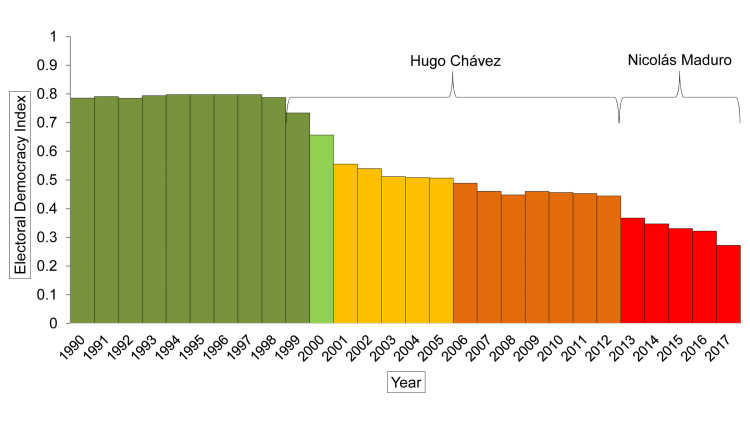
As a result, Venezuela reduced its oil shipments to the US and compromised its commercial commitments with its main creditor, China. With an economy so dependent on oil, most Venezuelan consumer goods are imported; the politicisation of the oil industry has been most damaging in terms of the collapse of production and imports, however. Chávez’s model of competitive authoritarianism depended on massive public spending to win elections; although this has now become unsustainable, his controls on foreign exchange and prices continue to exist as mechanisms of political control for authoritarian governance. This has led to economic collapse, protests, repression, and emigration.
Citizen insecurity operates in a similar way. According to Amnesty International’s most recent report (2018), the homicide rate in Venezuela is 89 such deaths per 100,000 inhabitants, a figure surpassed only by Syria. The report identifies young men from poor urban areas as the main victims. Police and military forces committed 22 per cent of these homicides. Under these conditions of violence, emigrants are fleeing not only from impoverishment and economic scarcity but also from the absence of physical protection by the state – and, indeed, the violence perpetrated by it too.
A Failed Petro-State with a Functional Repressive Regime
As the Venezuelan leadership has driven a process of increasing authoritarianism, the specific structural conditions of the country as a “petro-state” have weighed heavily. The term petro-state describes countries whose national economies depend on having 10 per cent or more of GDP made up of crude oil exports (Colgan 2013). According to data from the World Bank (2018) on the percentage of oil income in national economies since 1970, Venezuela is not only a petro-state par excellence but also moreover the only one in the Americas. This distinctive character has given it the ability to project its interests and values across the region during different historical stages. As part of the Chavista project, Venezuela has been able to weave a network of international patronage, especially in the Caribbean basin, which continues to serve as a political safety net. Thus far, this network has prevented a qualified majority forming against Venezuela within the framework of the OAS.
The Venezuelan petro-state has now lost much of its economic base, however. But this drop in production and income has not changed the structural nature of the petro-state, as there has been no diversification of exports. Rather, the decline of the oil industry, with the state-owned company Petróleos de Venezuela (PDVSA) at the forefront, has resulted in the unusual phenomenon of a “failed petro-state.” Political Science scholars have developed the categories “weak,” “failed,” and “collapsed” states (Rotberg 2010). In this sense, the failed petro-state allows for a distinction between state and government. Although the former has failed, the latter continues to operate as a mechanism for the extraction and exploitation of other resources, as well as an apparatus of arbitrary coercion and repression. Thus, the failed petro-state combines the worst of two worlds: limited control over national territory and arbitrary repression against the “internal enemy.”
In the event of a failing petro-state, border-monitoring capacities tend to fade away. In the Venezuelan case, this has become evident in the form of mass emigration. The blurring of the country’s borders is part of the predatory governmental apparatus’s survival mechanism, allowing the authoritarian regime to feed off the trafficking that it encourages. The failed petro-state exports migrants and refugees, trafficked goods, and ideological radicalism, thus effectively becoming an exporter of regional insecurity. Venezuela’s failed petro-state has emerged as an international political problem, as it is putting multilateral institutions to the test – which they have failed, as they were never designed for such a challenge. It has also exposed the precarious security and defence systems, as well as the fragility of the legal institutions and public services, in neighbouring countries.
Against this backdrop, the regime that commands the failed petro-state can nevertheless enjoy vitality, as evidenced by the resilience of Venezuelan authoritarianism (Mijares 2017a). Venezuela’s resilience is reinforced by the financial and logistical support provided by China and Russia, two powers with which Chávez cultivated close relations as counterweights to the West (especially the US) (Mijares 2017b) and to external pressures from within the country’s own region. The authoritarian failed petro-state therefore constitutes the perfect formula for forced migration, presenting a challenge to the regional organisations and to democratic governance in Latin America.
A Migration Crisis of Regional Dimensions
The Venezuelan migration crisis exhibits two characteristics that are unusual for Latin America, and especially for South America. First, the crisis is originating in a country which in modern history has generally received migrants and refugees rather than being the source of mass outmigration. Second, its dimensions are effectively regional.
From the 1950s onwards, the Venezuelan military regime had an open-door policy for immigration from Europe. This policy had underlying racist intentions, and gave birth to the commonly used expression “improving the race.” Under this normative framework Latin American immigration was rejected, with a few exceptions for the “white population” from the Southern Cone countries. With the arrival of democracy in 1958, a Latin Americanist policy was resumed, and embodied in the 1961 constitution. It established migratory and naturalisation priorities and provisions for all Latin American and Spanish migrants, with a special emphasis on the Andean countries.
The migrant networks facilitated the arrival of thousands of Spaniards, Portuguese, and Italians, mostly from the poorest regions of those countries, or – as in the case of Portugal – fleeing from the last colonial wars in Africa. They were joined by thousands of Colombians, Peruvians, and Ecuadorians, and a smaller number of Chileans and Argentines, with the latter two groups fleeing the military regimes of the 1970s and 1980s. The political stability of one of the most solid democracies in the region combined with the economic boost resulting from the increased world market prices for oil made Venezuela a major migration destination. Immigration slowed between the early 1980s and the late 1990s, as the Venezuelan economy deteriorated and its political institutions – especially its political parties – fell into crisis. In these years, those displaced by the Colombian armed conflict represented the bulk of migrants and refugees coming to Venezuela. This trend continued until 2015.
Outmigration from Venezuela began with a small flow of individuals who – because they had European citizenships – left the country after 1998, the year of Chávez’s first electoral victory. This first wave was mostly made up of business people and professionals who took their families into exile. Outmigration then became a major phenomenon in 2003, when the Chávez government dismissed more than 16,000 senior and middle managers, engineers, and technicians from PDVSA, accusing them of economic sabotage. The second wave corresponded with the global financial crisis of 2008–2009, when oil prices plummeted. Members of the professional middle class with moderate wealth moved to Spain, the US, and Colombia. The latter had already taken in oil engineers and technicians, who had helped raise oil production in that country to record levels. According to data from the World Bank (2018), in 2011 oil exports made up 6.4 per cent of Colombian GDP. In addition, in 2012 the value of mineral product exports from Colombia reached USD 42 billion, by far surpassing agro-exports, which remained at an average of USD 5 billion annually. This increase in mineral exports began in 2003 and coincided with the oil prices super-cycle and the first wave of Venezuelan immigrants arriving.
The most problematic wave of emigration from Venezuela, especially for neighbouring Colombia, has been the one that began in 2014. It came in the wake of the brutally repressed student protests (Mijares 2014) and the expulsion of approximately 21,000 Colombians in 2015, under the pretext that they were part of criminal and espionage networks operating in Venezuela to harm the Maduro government. This wave has intensified since 2016, reaching its highest levels in 2018. In the four years since 2014, approximately 2.3 million Venezuelans (out of a population of 32 million people) have left the country.
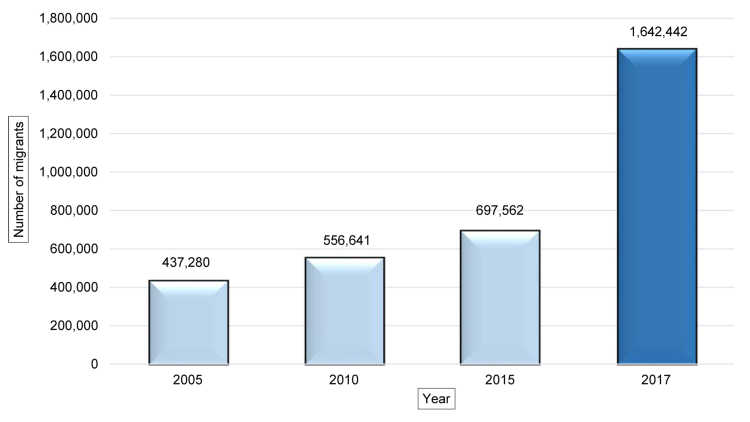
This third wave of Venezuelan migrants has been made up mostly of members of the impoverished middle class and other vulnerable sectors of the population, whose income does not allow them to purchase air tickets. Many do not have passports and have therefore utilised the mobility provisions provided by the Andean Community (an integration scheme from which Venezuela withdrew in 2006, arguing that the free trade agreements of Colombia and Peru had annulled the pact – but which continues to provide benefits to the Venezuelans).
According to the July 2018 report of Migración Colombia, the migration agency of the Colombian Ministry of Foreign Affairs, at least 870,000 Venezuelans had come to Colombia – via both regular and irregular entries. This represented an increase of 5 per cent compared to the last report submitted by Migración Colombia in June 2018, and of 58 per cent compared to 2017. Of these 870,000 Venezuelans, approximately 382,000 (44 per cent) had a regular status, approximately 442,000 (51 per cent) were in the process of regularisation, and approximately 46,000 (5 per cent) had irregular status (Migración Colombia 2018). According to Christian Krüger, director of the agency: “[Colombian migration authorities] have regularised more than 382,000 and we are waiting for the signing of the decree by the national government to begin the regularisation of the more than 442,000 Venezuelans who make up the Administrative Registry for Venezuelan Migrants. This would allow us to have close to 95 per cent of the Venezuelan population in Colombia regularised” (Migración Colombia 2018).
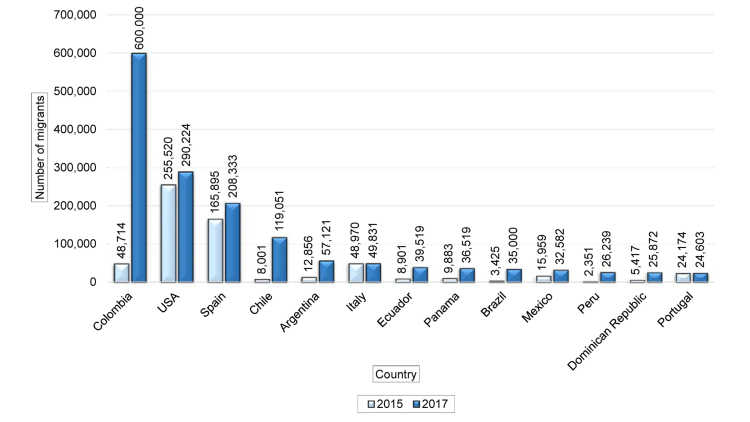
Colombia also has become a major transit country for Venezuelan migrants on their way to Ecuador, Peru, Chile, and Argentina (Migración Colombia 2018). This tendency to cross Colombia as a transit zone reflects the limited demographic corridors of the region. Venezuelans seeking to reach the other countries of South America follow the complex route of the Colombian mountain ranges before they reach the border with Ecuador, the gateway to Peru, Chile, and Argentina. In addition to Colombia, these other countries have made efforts to accommodate the migratory wave. However their capacities differ, as do their political responses. For example, Ecuador and Peru temporarily closed their borders to Venezuelans without a passport. For many Venezuelans it is difficult to obtain one, as the government in Caracas alleges that it does not have the materials for the necessary security elements thereof. The Ecuadorian and Peruvian decisions were later lifted by their courts because they violated Andean Community regulations.
The other corridor leads the Venezuelan migrants to northern Brazil. Although the number of migrants taking this route is much lower than to Colombia, the arrival of Venezuelans has altered life here too. In the Brazilian border town of Pacaraima, on 18 August 2018, a Brazilian merchant was injured in an assault attributed to Venezuelans. The next day a mob partially destroyed the camp of 2,000 Venezuelans in this town of 12,000 inhabitants (El Universal 2018).
The massive and uncontrolled exodus from Venezuela has generated informality, has tested the public services in the peripheral zones of the country’s South American neighbours, has upset these country’s migratory policies, and has already generated occasional surges of xenophobia. If we can learn something from the great migration waves in other regions, such as Europe, it is that they have become fuel for the rise of nationalist populism (Ruzza 2018). There is a real risk that extremist political actors in South America will be able to capitalise on this development and gain influence or even capture local or national power too.
Democratic Governability under Diminished Regional Governance Conditions
In Venezuela, opposition groups have been incapable of forcing political change. However, more dramatic still is the fact that the same is true of Latin America as a whole. Here, the Venezuelan crisis and the resulting waves of migration are challenging the democratic governability of the region at a time of declining regional governance. This is especially evident in the case of the Union of South American nations (UNASUR) – the figurehead institution of post-hegemonic regionalism (Riggirozzi and Tussie 2012) that emerged from the rise of leftist governments during the first decade of the twenty-first century, led by Brazil and Venezuela. This new regional institution undermined the foundations of the OAS, thereby restraining US influence.
However, the deterioration of Venezuelan democracy has been the hardest test for UNASUR (Hoffmann, Mijares, and Schenoni 2015). The lack of regional leadership given the political and economic decline of Brazil, the ideological tensions, the absence of a supra-regional institution, and, above all, the competition to separate national independence from the project of regional autonomy have undermined the organisation, leading to its imminent collapse in the face of the complex Venezuelan situation (Mijares and Nolte 2018). This institutional vacuum when it comes to crisis management has contributed to the resurgence of the OAS under Secretary General Luis Almagro, and the renewed interest of the US under the Trump administration. These trends point to the resumption of a political and security path following a hemispheric plan, in the face of the failure of regional efforts. Moreover, the vacuum has generated debate about the need for, and possibility of, military intervention so as to end the humanitarian crisis in Venezuela.
Latin American and Caribbean history is full of examples of intervention, direct or indirect, by the US. In the academic and political spheres of South America any such approach is met with disapproval. Thus, the Lima Group, an ad hoc mechanism arising from the failure to apply the Inter-American Democratic Charter against the Maduro regime within the OAS framework, has agreed that they will not endorse any form of military intervention in Venezuela (Fowks 2018). However, Colombia and Guyana – neighbours of Venezuela with pending border conflicts – together with Canada refused to sign the Lima Group statement, thus reopening the controversy about possible military intervention.
The Venezuelan crisis is testing the capacities and institutions of the entire Western Hemisphere, as South American governance is in decline. It also raises questions about democratic governance in the region. Latin America has managed to establish democratic regimes and to constitute itself as a region that, within the framework of the Global South, shows a clear trend towards democracy. However most national institutions remain fragile, especially in the region surrounding Venezuela. Colombia is going through a critical period of post-peace agreements in which implementation has been a major problem. Dissident factions of the Revolutionary Armed Forces of Colombia (FARC) guerrilla organisation continue to threaten internal security, and illicit crops have reached record levels. The National Liberation Army guerrilla group, for its part, remains reluctant to submit to an agreement similar to that signed by the government of Juan Manuel Santos and the FARC in 2016, despite the ultimatums issued by the Colombian government under its recently elected president Iván Duque. These conditions threaten to plunge Colombia back into the armed conflict, albeit with the support of the US, while the vulnerable Venezuelan migrants’ movement through the country is creating conditions for the failure of public services, an increase in crime and xenophobia, and the victimisation of the migrants themselves.
Meanwhile, Brazilian political fragmentation is giving way to polarisation. The campaign success of right-wing leader Jair Bolsonaro in the country’s presidential elections underscores the potential of extremist and nationalist politicians (see Flemes 2018). The Economist (2018) has described Bolsonaro as a threat to Brazilian democracy, drawing attention to the effects that he could have on the rest of South America. However the risk is not only the potential victory of this candidate, but also the confrontation with the Workers’ Party (PT) of former presidents Lula da Silva and Dilma Rousseff. Venezuela has long been a bone of contention in Brazil’s polarised politics, with the PT seen as a regional ally of Chávez and Maduro. The Brazilian right has condemned the Venezuelan regime as a socialist dictatorship that must be confronted by all available means. In the midst of this, the current migration crisis is raising tensions and encouraging xenophobia, especially in the north of Brazil, leading to calls for unilateral hard-line solutions.
In order to provide adequate coverage of the Venezuelan migration crisis, and also proper assistance to the migrants themselves, it is important to recognise these events as being a regional emergency. However, democratic governance presupposes a delicate balance between governability and democracy. The relationship between the state and democracy is conflictive by definition, with the former being a mechanism for the concentration of power and the second being one of de-concentration (Guevara 1997). Thus, governability through the application of state power is necessary to address crises in the midst of an emergency situation – one prone to the violation of basic principles of democracy, such as controls on governmental actions. With the securitising of outmigration, the risk increases; in the regional environment of Venezuela, especially in Colombia and Brazil, the tendency to use military forces for domestic security tasks jeopardises, meanwhile, the integrity of migrants and the rule of law in the region.
Addressing Consequences and Causes: Hemispheric Efforts Required
According to Christian Krüger, if Maduro’s government in Venezuela continues, the exodus will go on (Migración Colombia 2018). Krüger’s claim leads to the central debate on the problem for Latin America, and above all for Venezuela’s neighbours: Should efforts be directed only towards addressing the consequences of forced migration, or its causes as well? If we accept the thesis of the director of Migración Colombia, the Venezuelan government is deliberately causing the crisis and exporting insecurity. The dilemma lies, then, in what to do when, on the one hand, the Venezuelan government remains closed to any possibility of peaceful political change, and, on the other, most Latin American governments – especially those that are part of the Lima Group – do not support any means other than diplomatic pressure.
It seems realistic to accept that the only internal actor that can persuade the Venezuelan government to pursue a democratic (re)opening is the military. However, many of the high-ranking officials within Venezuela’s armed forces have been accused of drug trafficking by US authorities, while the middle- and lower-level ones could face national and international trials for human rights violations. Despite this, the US government has sent amnesty signals to the Venezuelan military for the presumed purpose of encouraging a bloodless coup d’état that allows a transitional junta to call elections, permitting the return to democracy (Londoño and Casey 2018). This type of operation would minimise the costs of an intervention, but it is highly complex considering the penetration of political commissaries in the Venezuelan armed forces – as well as the conflicts of interest that would be created between the commanders. In addition, most of the international community and regional governments would refuse to recognise a governmental structure that originated in an act of force.
The above scenario presupposes the reactivation of the OAS as a mechanism of hemispheric political agreement, to face the titanic task of bringing about a transition in the region’s well-armed and unstable authoritarian petro-state. Letting the crisis run on unendingly will increase emigration and the harmful effects on the democratic governability of the region. In addition, Latin America will run the risk that the Venezuelan crisis becomes a model for authoritarian tendencies elsewhere – as, indeed, is beginning to be the case with Nicaragua, with its violent repression of university students. The authorities in Costa Rica and Honduras have already reported the arrival of emigrants displaced by the violence in Nicaragua, where President Daniel Ortega has in 2018 imitated the repressive practices of Nicolás Maduro in 2014 and 2017. Thus, while the Venezuelan challenge is primarily affecting its immediate neighbours, any solution must go beyond just them – specifically by using the surviving hemispheric institutional framework provided by the OAS.
Fußnoten
Literatur
Amnesty International (2018), Amnesty International Annual Report 2017/18, www.amnesty.org/en/latest/research/2018/02/annual-report-201718/ (21 September 2018).
Colgan, Jeff D. (2013), Petro-Aggression: When Oil Causes War, London: Cambridge University Press.
Coppedge, Michael et al. (2018), V-Dem [Country-Year/Country-Date] Dataset v8. Varieties of Democracy (V-Dem), https://doi.org/10.23696/vdemcy18 (24 September 2018).
Cunningham, Nick (2018), No End in Sight for Venezuela’s Oil Crisis, https://oilprice.com/Energy/Energy-General/No-End-In-Sight-For-Venezuelas-Oil-Crisis.html (24 September 2018).
El Universal (2018), Brasileños atacan campamento de migrantes venezolanos en Roraima, 18 August, www.eluniversal.com/internacional/18158/brasilenos-ata can-campamento-de-migrantes-venezolanos-en-roraima (21 September 2018).
Flemes, Daniel (2018), Brazil’s Elections: Nationalist Populism on the Rise, GIGA Focus Latin America, 5, September, www.giga-hamburg.de/de/publikationen/11567469-wahl-brasilien-rechtspopulismus-vormarsch (21 September 2018).
Fowks, Jacqueline (2018), El Grupo de Lima rechaza cualquier intervención militar en Venezuela, in: El País, 16 September, https://elpais.com/internacional/2018/09/16/america/1537061395_976072.html (21 September 2018).
Guevara, Pedro (1997), Estado vs. Democracia, Caracas: Universidad Central de Venezuela.
Hoffmann, Anne Marie, Víctor M. Mijares, and Luis Schenoni (2015), Die Krise in Venezuela – Prüfstein für die UNASUR, GIGA Focus Lateinamerika, 3, May, www.giga-hamburg.de/de/publikationen/11569675-krise-venezuela-prüfstein-unasur (21 September 2018).
International Organization for Migration (2018), Migration Trends in the Americas. Bolivarian Republic of Venezuela, http://robuenosaires.iom.int/sites/default/files/Informes/National_Migration_Trends_Venezuela_in_the_Americas.pdf (24 September 2018).
Levitsky, Steven, and Lucan A. Way (2010), Competitive Authoritarianism: Hybrid Regimes After the Cold War, London: Cambridge University Press.
Londoño, Ernesto, and Nicholas Casey (2018), Trump Administration Discussed Coup Plans With Rebel Venezuelan Officers, in: The New York Times, 8 September, www.nytimes.com/2018/09/08/world/americas/donald-trump-venezuela-military-coup.html (21 September 2018).
Migración Colombia (2018), Más de 870 mil venezolanos están radicados en Colombia, in: Comunicado Oficial de Migración Colombia, http://migracioncolombia.gov.co/index.php/es/prensa/comunicados/comunicados-2018/julio-2018/7929-mas-de-870-mil-venezolanos-estan-radicados-en-colombia (21 September 2018).
Mijares, Víctor M. (2017a), Die Resilienz des venezolanischen Autoritarismus, GIGA Focus Lateinamerika, 2, March, www.giga-hamburg.de/de/publikationen/11570045-resilienz-venezolanischen-autoritarismus (21 September 2018).
Mijares, Víctor M. (2017b), Soft Balancing the Titans: Venezuelan Foreign-Policy Strategy Toward the United States, China, and Russia, in: Latin American Policy, 8, 2, 201–231.
Mijares, Víctor M. (2014), Proteste in Venezuela und die Krise des Chavismus, GIGA Focus Lateinamerika, 2, March, www.giga-hamburg.de/de/publikationen/11576436-proteste-venezuela-krise-chavismus (21 September 2018).
Mijares, Víctor M., and Detlef Nolte (2018), Regionalismo post-hegemónico en crisis. ¿Por qué la Unasur se desintegra?, in: Foreign Affairs Latinoamérica, 18, 3, 105–112.
OPEC (2018), Monthly Oil Market Report, www.opec.org/opec_web/en/publications/338.htm (24 September 2018).
Riggirozzi, Pia, and Diana Tussie (eds) (2012), The Rise of Post-Hegemonic Regionalism. The Case of Latin America, Dodrecht: Springer.
Rotberg, Robert I. (2010), The Failure and Collapse of Nation-States: Breakdown, Prevention, and Repair, in: Robert I. Rotberg (ed.), When States Fail: Causes and Consequences, New Jersey: Princeton University Press, 1–50.
Ruzza, Carlo (2018), The Radical Right in Southern Europe, in: Jens Rydgren (ed.), The Oxford Handbook of Radical Right, Oxford: Oxford University Press, 505–520.
The Economist (2018), Brasília, We have a Problem. The Danger Posed by Jair Bolsonaro, www.economist.com/leaders/2018/08/11/the-danger-posed-by-jair-bolsonaro (24 September 2018).
World Bank (2018), Oil Rents (% of GDP), http://api.worldbank.org/v2/en/indicator/NY.GDP.PETR.RT.ZS?downloadformat=excel (21 September 2018).
Gesamtredaktion GIGA Focus
Redaktion GIGA Focus Lateinamerika
Lektorat GIGA Focus Lateinamerika
Regionalinstitute
Forschungsschwerpunkte
Wie man diesen Artikel zitiert
Mijares, Víctor M., und Nastassja Rojas Silva (2018), Venezuelas Migrationskrise bedroht die demokratische Regierbarkeit der Region, GIGA Focus Lateinamerika, 6, Hamburg: German Institute for Global and Area Studies (GIGA), http://nbn-resolving.de/urn:nbn:de:0168-ssoar-59911-3
Impressum
Der GIGA Focus ist eine Open-Access-Publikation. Sie kann kostenfrei im Internet gelesen und heruntergeladen werden unter www.giga-hamburg.de/de/publikationen/giga-focus und darf gemäß den Bedingungen der Creative-Commons-Lizenz Attribution-No Derivative Works 3.0 frei vervielfältigt, verbreitet und öffentlich zugänglich gemacht werden. Dies umfasst insbesondere: korrekte Angabe der Erstveröffentlichung als GIGA Focus, keine Bearbeitung oder Kürzung.
Das German Institute for Global and Area Studies (GIGA) – Leibniz-Institut für Globale und Regionale Studien in Hamburg gibt Focus-Reihen zu Afrika, Asien, Lateinamerika, Nahost und zu globalen Fragen heraus. Der GIGA Focus wird vom GIGA redaktionell gestaltet. Die vertretenen Auffassungen stellen die der Autorinnen und Autoren und nicht unbedingt die des Instituts dar. Die Verfassenden sind für den Inhalt ihrer Beiträge verantwortlich. Irrtümer und Auslassungen bleiben vorbehalten. Das GIGA und die Autorinnen und Autoren haften nicht für Richtigkeit und Vollständigkeit oder für Konsequenzen, die sich aus der Nutzung der bereitgestellten Informationen ergeben.






